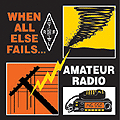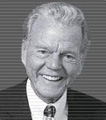|
Ham radio is essential to homeland security in the United States. Our service is a dispersed and decentralized communications system that can't be shut down by terrorist attck. While public safety agencies rely on central dispatch stations, amateur radio operators can go on the air just about anywhere anytime. Hams are trained communicators with technical knowledge that prepares them to put their stations on the air at remote sites quickly, creating makeshift facilities when needed. Amateur radio operators don't have to wait for technicians to arrive to repair equipment or re-program computers. Hams can do it themselves on the fly. |
|||
|
Amateur radio operators have proven themselves to be essential volunteer responders in weather and other natural emergencies, and disasters of human origin. Hams can go on the air and stay on the air when ordinary public service communications fail. For many decades, ham radio often has been the only means of communicating from a stricken area to the outside world for hours and sometimes even days. |
|||
|
Radio amateurs have unique capabilities. The telephone companies can't afford to build cellphone towers everywhere. There are big holes in coverage of sparsely populated areas away from cities and Interstate highways. Ham radio, on the other hand, is everywhere. During disasters, amateur radio volunteers can work without any fixed infrastructure. We're mobile and we're portable. Of course, we do have a huge infrastructure in place, also. For example, the ARRL Repeater Directory 2006-2007 lists 20,389 VHF and UHF repeaters across the U.S. and Canada. And then there are hundreds of thousands of homes and cars outfitted with two-way radio transceivers on HF, VHF and UHF bands. Whether or not there are towers to receive and repeat their signals, we can't help but notice there are cellphones everywhere. Unfortunately, the one-on-one nature of cellphone calls makes it almost impossible for a large group of emergency workers all at the same time to get an overall picture of how an event is developing. When an emergency manager is taking a call from one person, he or she miss calls from others. Also, cell networks can go down when conditions are most critical. Towers can become disabled by the very conditions that may have caused an emergency and cellular networks can be flooded out with panic calls placed by members of the general public. Hams operate nets all over the HF, VHF and UHF bands, while public safety agencies and related industries have narrow two-way systems on one or a few frequencies with what they call dispatchers. Those public safety agencies – such as police and fire departments, ambulance companies, rescue squads and the power and telephone companies and other outfits that are part of the nation's critical infrastructure – can't afford to provide the kinds of widespread, distributed radio communications networks for themselves that hams already have. Instead, those agencies that radio amateurs work with during emergencies have to rely on ham radio. Radio amateurs bring more than two-way voice communications to emergencies. Here are some of the additional services hams can offer:
|
|||
|
Those public service agencies served by radio amateurs get more than the latest technology. They get the hams themselves – dedicated workers who are trained specifically in emergency communications. Training and experience in unexpected emergencies make radio amateurs more likely to convey accurate information over their radio systems. In fact, the served agencies get a close-knit collection of experienced, disciplined volunteers who know how to work together as team. For many hams, solving communications challenges is what amateur radio is all about. Because they are dedicated communicators, hams aren't as likely to miss key information shared on a net while agency leaders are busy doing other things. Radio amateurs often can see the big picture and provide information support to agency leaders during a crisis simply because the hams have been monitoring emergency nets and know more about what's going on at any one moment than the agency leadership. |
National Emergency Resources Online |
||
|---|---|---|---|
American Radio Relay League Amateur Radio Emergency Service Amateur Radio Emergency Nets Amateur Radio Public Service Public Service Communications Manual National Traffic System (NTS) ARRL Online Net Directory Amateur Radio Emergency Communications Courses Radio Amateur Civil Emergency Service Skywarn Salvation Army Team Emergency Radio Net REACT International Memoranda of Understanding with Agencies North Carolina ARES Some of many major nets active in emergencies: SKYWARN The Waterway Radio & Cruising Club Net Salvation Army Team Emergency Radio Net (SATERN) Hurricane Watch Net at the National Hurricane Center Amateur Radio Station WX4NHC at the National Hurricane Center Memoranda of Understanding documents: American Red Cross National Weather Service Department of Homeland Security - FEMA - Citizen Corps (pdf) Association of Public-Safety Communications Officials - International National Communications System National Association of Radio and Telecommunications Engineers (pdf) Salvation Army Society of Broadcast Engineers Quarter Century Wireless Association (pdf) Radio Emergency Associated Communication Teams Civil Air Patrol (CAP) (pdf) U.S. federal government: The White House Office of Homeland Security Federal Emergency Management Agency FEMA Project Impact FEMA Mitigation FEMA Kids FEMA Emergency Management Institute Dept. of Defense Emergency Preparedness Policy Disaster Finder SBA Disaster Site Citizen Emergency Response Team Department of Justice USA Freedom Corps Medical Reserve Corps Persons with Disabilities Peace Corps |
National and international organizations:
National Voluntary Organizations Active in Disaster American Red Cross National Crime Prevention Council National Neighborhood Watch Program AmeriCorps World Wide Disaster Relief National Emergency Management Association International Association of Emergency Managers Internet Disaster Information Network National Disaster Communication Response Team National Emergency Resouce Information Network AlertNet from Reuters Disaster Response Network ICES Disaster Resources Senior Corps Disaster Related Networks on the WWW Volunteers of America Volunteers in Technical Assistance America's Second Harvest Ananda Marga Universal Relief Team Humane Society of the United States International Relief Friendship Foundation International Aid National Emergency Response Team National Organization for Victim Assistance Northwest Medical Teams International The Phoenix Society For Burn Survivors The Points Of Light Foundation United States Service Command World Vision Alliance of Information and Referral Systems C.O.R.P., Inc. DERA International Disaster Resource Guide Institute for Business and Home Safety InterAction Nippon Volunteer Network Active in Disaster Special Medical Assistance Response Teams Voluntary Organisations in Cooperation in Emergencies Association of Volunteer Emergency Response Teams Craft Emergency Relief Fund DERA International Disaster Related Networks on the WWW Working with children in a disaster Shelter Net Religious organizations: Catholic Charities USA Christian Disaster Response Christian Reformed World Relief Committee Church Of The Brethren Church World Service Episcopal Relief and Development Friends Disaster Service Lutheran Disaster Response Mennonite Disaster Services Nazarene Disaster Response Presbyterian Disaster Assistance The Salvation Army Society Of St. Vincent De Paul Southern Baptist Disaster Relief United Jewish Communities United Methodist Committee On Relief American Baptist Men USA Adventist Community Services North Carolina Interfaith Disaster Response |
||
|
|||
| Sources: QST, CQ, ARRL, FEMA, NVOAD, SATERN | |||
K3RXK Site Map Search this Site © 2005 K3RXK

